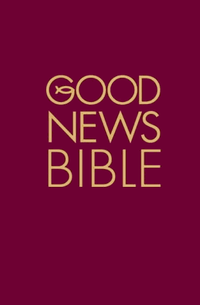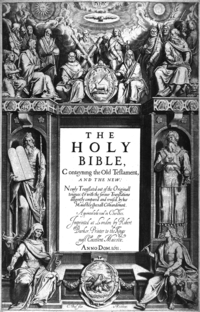Good News Bible
Good News Bible (GNB), also called the Good News Translation (GNT) in the United States, is an English translation of the Bible by the American Bible Society. It was first published as the New Testament under the name Good News for Modern Man in 1966. It was anglicised into British English by the British and Foreign Bible Society with the use of metric measurements for the Commonwealth market. It was formerly known as Today's English Version (TEV), but in 2001 was renamed the Good News Translation in the U.S., because the American Bible Society wished to improve the GNB's image as a translation where it had a public perception as a paraphrase.[1] Despite the official terminology, it is still often referred to as the Good News Bible in the United States. It is a multi-denominational translation, with editions used by many Christian denominations. It is published by HarperCollins, a subsidiary of News Corp.
| Good News Bible | |
|---|---|
 The international cover of the Good News Bible, used since 2004 | |
| Full name | Good News Bible |
| Other names | Good News Translation, Today's English Version |
| Abbreviation | GNB (or GNT/TEV) |
| OT published | 1976 |
| NT published | 1966 |
| Complete Bible published | 1976 |
| Textual basis | Medium Correspondence to Nestle-Aland Novum Testamentum Graece 27th edition |
| Translation type | Dynamic equivalence |
| Publisher | Bible Societies, HarperCollins |
| Copyright | American Bible Society 1966, 1967, 1970, 1971, 1976, 1979 (Deuterocanonicals/Apocrypha), 1992; Anglicizations British and Foreign Bible Society 1994 |
In the beginning, when God created the universe, the earth was formless and desolate. The raging ocean that covered everything was engulfed in total darkness, and the Spirit of God was moving over the water. Then God commanded, "Let there be light" — and light appeared.
For God loved the world so much that he gave his only Son, so that everyone who believes in him may not die but have eternal life. | |
Seach
Beginnings
The beginnings of the Good News Bible can be traced to requests made by people in Africa and the Far East for a version of the Bible that was easier to read. In 1961, a home missions board also made a request for the same type of translation. Besides these requests, the GNB was born out of the translation theories of linguist Eugene Nida, the Executive Secretary of the American Bible Society's Translations Department. In the 1960s, Nida envisioned a new style of translation called Dynamic equivalence. That is, the meaning of the Hebrew and Greek would be expressed in a translation "thought for thought" rather than "word for word". The dynamic theory was inspired by a Spanish translation for Latin American native peoples.
The American Bible Society, impressed with Nida's theories, decided to use them. Due to these requests and Nida's theories, Robert Bratcher[2] (who was at that time a staffer at the American Bible Society) did a sample translation of the Gospel of Mark. This later led to a translation of the full New Testament. The result, titled Good News for Modern Man: The New Testament in Today's English Version, was released in 1966 as a 599-page paperback with a publication date of January 1, 1966. It received a mass marketing effort with copies even being made available through grocery store chains. The New Testament would see second, third, and fourth editions released in 1967, 1971, and 1976, respectively.[3]
The Psalms were published in 1970 as The Psalms For Modern Man in Today's English Version.[4] Other portions of the Old Testament began to appear over the course of the 1970s - Job in 1971, Proverbs and Ecclesiastes in 1972, Jonah in 1973, Ruth, Hosea, Amos, and Micah in 1974, and Exodus in 1975.[5]
In 1976, the Old Testament was completed and published as the Good News Bible: The Bible in Today's English Version. In 1979, the Apocryphal/Deuterocanonical Books were added to the Good News Bible and published as Good News Bible: Today's English Version with Deuterocanonicals/Apocrypha and also later published as part of subsequent Catholic and Orthodox Editions. In 1992, the translation was revised with inclusive language.
The Bible Societies released the Contemporary English Version in 1995, also using jargon-free English. While this translation is sometimes perceived as a replacement for the GNB, it was not intended as such, and both translations continue to be used.[6] While the American Bible Society promotes both translations, the British and Foreign Bible Society and HarperCollins have since 2007 refocused their publishing efforts on the GNB including the Good News Bible iPhone App.[7]
Popularity
| The Bible in English |
|---|
 Title page to the King James Version |
|
|
|
The GNB has been a popular translation used across multiple denominations of Christianity. By 1969, Good News for Modern Man had sold 17.5 million copies. By 1971, that number had swelled to 30 million copies. It has been endorsed by Billy Graham and several Christian denominations, including the Catholic Church in the United States (Today's English Version, Second Edition),[8] the Southern Baptist Convention, and the Presbyterian Church (USA). Excerpts from the New Testament were used extensively in evangelistic campaigns, such as the Billy Graham crusades and others, from the late 1960s right through to the early 1980s. In 1991, a Gallup poll of British parishioners showed that the GNB was the most popular Bible version in that nation. In 2003, the GNB was used as the basis for a film version of the Gospel of John.[9] In 2008, Swedish group Illuminated World paired the text of the GNB with contemporary photography for the English translation of Bible Illuminated: The Book.[10]
Features
The GNB is written in a simple, everyday language, with the intention that everyone can appreciate it, and so is often considered particularly suitable for children and for those learning English. There are introductions to each book of the Bible. Unlike most other translations, some editions of the GNB contain line drawings of biblical events with a snippet of text. The line drawings were done by Annie Vallotton (1915–2014).[11] However, Vallotton is credited with doing the drawings only in certain editions of the GNB—in others, the drawings are simply credited to "a Swiss artist".
Since the focus is strongly on ease of understanding, poetry is sometimes sacrificed for clarity. This choice can be seen in the example quotation of John 3:16, which is rendered, "For God loved the world so much that …", which is more conversational than the familiar "For God so loved the world". The phrase contains a figurative, if not literal, translation: the Greek word for "so" in that passage is οὕτως,[12] which likely means "in such a way" as well as "so much".[13] Because the implication of the phrase "in such a way that he would sacrifice his only son" includes the implication of "so much" and could certainly not include the opposite "loved the world so little," the translators chose the phrase "so much" for its brevity and clarity.
See also
- American Bible Society
- The Gospel of John - a movie based word-for-word on the Good News Bible.
- Bible translations into English
- List of English Bible translations
References
Citations
- "Archived copy". Archived from the original on February 12, 2006. Retrieved 2004-01-09.CS1 maint: archived copy as title (link) CS1 maint: BOT: original-url status unknown (link)
- Robert Bratcher obituary
- http://bibles.wikidot.com/tev
- "The Psalms for Modern Man: The Psalms in Today's English Version". 1970.
- http://bibles.wikidot.com/tev
- "This Lamp: Good News Bible". Archived from the original on 2009-07-24. Retrieved 2009-03-22.
- www.goodnewsbible.com - Good News Bible iPhone App
- USCCB Approved Translations of the Sacred Scriptures
- "Gospel of John" DVD/Videorecording End Credits. Philip Saville, Director. Buena Vista Home Entertainment. Burbank, CA: 2003.
- Illuminated World: A Contemporary Bible Publication website
- "One of the world's best-selling artists was a Bible illustrator". United Bible Societies. Retrieved 29 May 2016.
- The New Greek-English Interlinear New Testament translated by Robert K. Brown and Philip W. Comfort, edited by J.D.Douglas ISBN 0-8423-4564-7 translates οὕτως γὰρ as "for~thus", where "~" indicates an inversion of Greek word order to make the interlinear rendering more readable ("for thus God loved the world")
- NET Bible (First ed.). 2009. first footnote in John 3:16 (footnote number 36).
The Greek adverb οὕτως (Joutws) can refer (1) to the degree to which God loved the world, that is, to such an extent or so much that he gave his own Son (see R. E. Brown, John [AB], 1:133-34; D. A. Carson, John, 204) or (2) simply to the manner in which God loved the world, i.e., by sending his own son (see R. H. Gundry and R. W. Howell, “The Sense and Syntax of John 3:14-17 with Special Reference to the Use of Οὕτως…ὥστε in John 3:16,” NovT 41 [1999]: 24-39). Though the term more frequently refers to the manner in which something is done (see BDAG 741-42 s.v. οὕτω/οὕτως), the following clause involving ὥστε (Jwste) plus the indicative (which stresses actual, but [usually] unexpected result) emphasizes the greatness of the gift God has given. With this in mind, then, it is likely (3) that John is emphasizing both the degree to which God loved the world as well as the manner in which He chose to express that love
Bibliography
- Metzger, Bruce. The Bible in Translation, pp. 167–168.
- Sheeley, Steven M. and Nash, Jr., Robert N. Choosing A Bible, pp. 38, 52-53.
External links
- Good News Bible (goodnewsbible.com)
- Official website (GNT.Bible) - for the Good News Translation
- Good News Bible text
- Good News Bible Bible Society page describing 2004 editions
- The best-selling artist of all time? BBC News article highlighting the illustrations of Annie Vallotton in the Good News Bible